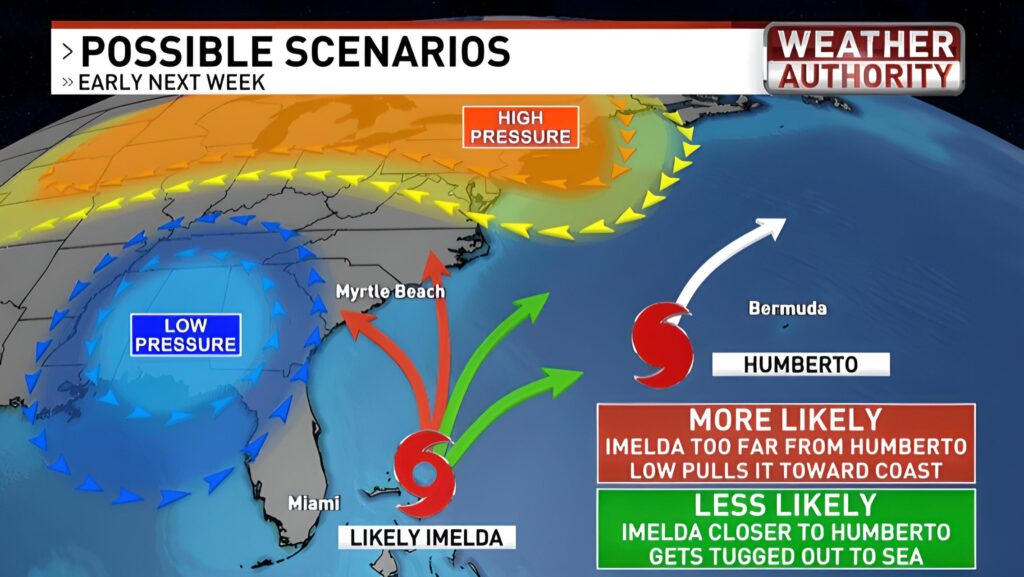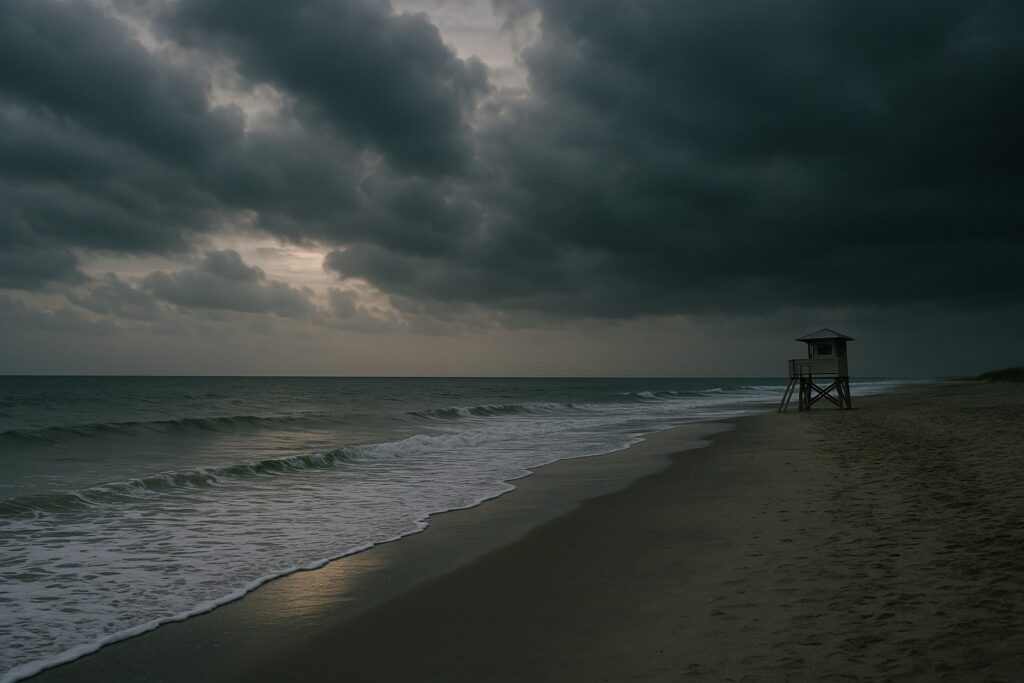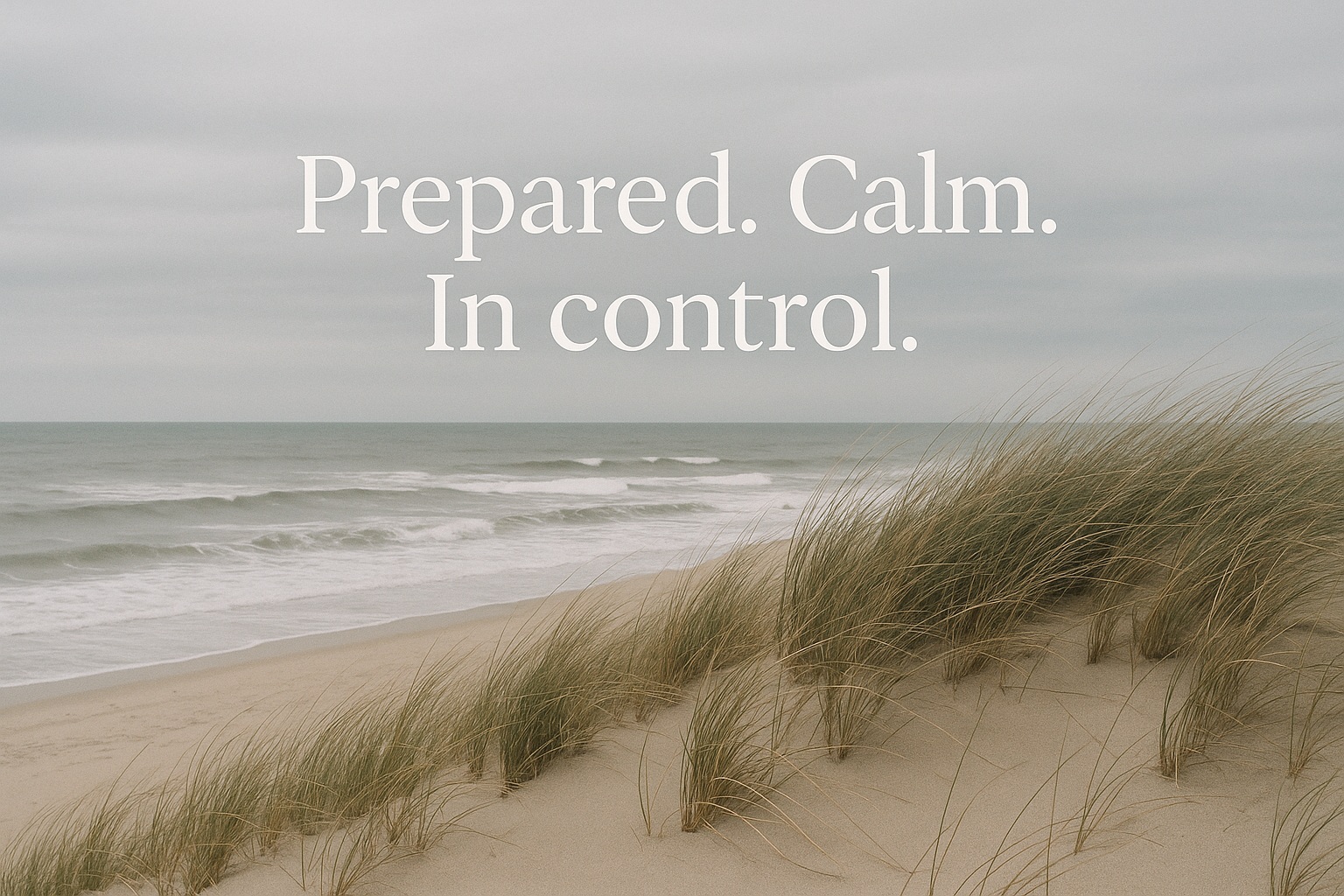Your North Myrtle Beach Storm Survival Guide — What to Do Now (and If You Have to Evacuate)
Last updated: 9/26/2025
Why you should read this now
At Thomas Beach Vacations, your safety is our top priority. This guide is your companion: what to do before, during, and after a storm — especially if evacuation orders arise.
We’ve drawn from official sources (City of North Myrtle Beach, Horry County Emergency Management, SCEMD) and our own experience hosting guests through storms. Use it, share it, bookmark it.

-
Know Your Risk: Zones, Alerts & Evacuation Authority
→ Hurricane season & local context
- Atlantic hurricane season runs from June 1 to November 30.
- North Myrtle Beach maintains a Hurricane / Storm Preparedness section on its city website, which includes evacuation planning, zoning, and reentry policies.
- Thomas Beach Vacations already publishes a “Detailed Hurricane Preparedness Guide” for tourists, which emphasizes signing up for local alerts, checklists, and evacuation route awareness.
→ Know Your Evacuation Zone (“Know Your Zone”)
- Horry County runs a “Know Your Zone” public education campaign that classifies areas into Zone A, Zone B, Zone C, based primarily on storm surge vulnerability, rather than storm category.
- Even if your address is outside a zone, you may still face high winds, flooding, tornadic activity, or utility outages — don’t assume safety from negligence.
- The City of North Myrtle Beach posts maps and guidelines for reentry, and enforces identification requirements for residents and property owners returning after evacuation.
→ Who can order an evacuation?
- In South Carolina, only the Governor has the legal authority to issue a mandatory evacuation.
- When a mandatory order is issued, it becomes enforceable.
- Upon such an order, traffic patterns may change: contraflow/lane reversal will be activated on key highways (e.g., US 501) to speed outbound traffic.
- Beware: Once you enter a reversed-lane route, you cannot turn back unless directed by law enforcement.
→ Evacuation routes for North Myrtle Beach
- If you are north of Briarcliffe Acres, your route is typically SC-9 north to I-95 and beyond.
- If you are south toward Briarcliffe Acres / toward Myrtle Beach, you’ll likely use SC-22 to US-501 to Marion, or other designated paths, depending on location.
- Law enforcement and National Guard may staff these routes to assist and enforce proper flow.
- Deviating from official routes can result in delays or necessitate rerouting.
-
Before the Storm: Your Window to Prepare
This is your golden window — ideally 48–72 hours before landfall — to make crucial decisions and prepare. The faster you act, the more options remain open.
→ Sign up for alerts, establish communication
- Local alerts: Register for Regroup alerts (for North Myrtle / City) and CodeRED/reverse 9-1-1 (Horry County).
- NOAA Weather Radio is a must (frequency:162.550 MHz) to stay updated if internet or cell service fails.
- Establish a communication plan: Know who you’ll call, how you’ll meet (if separated), keep a list of emergency contacts (local authorities, Thomas Beach Vacations, your family).
- Create waterproof and digital copies of identification, rental agreements, insurance, passports, medical records.
→ Finalize your evacuation decision (or commit to sheltering)
- If a mandatory order is expected, plan to leave early. Waiting until the last hour amplifies risk and traffic congestion.
- If you plan to stay (only advised when allowed), ensure your lodging is structurally sound, well-located, and capable of protecting you from high winds, flooding, and power loss.
- Use a decision tree:
• Mandatory evacuation → depart now
• No evacuation but increasing storm threat → prepare to shelter in place
• Decide your fallback plan (where to go, how to get there)
→ Stock up and build your emergency kit
Based on North Myrtle Beach’s Hurricane Preparedness guidance:
Include:
| Category | Recommended Items |
| Water & Food | At least 1 gallon per person per day for 3–7 days; non-perishable food, manual can opener |
| Lighting & Power | Flashlights, extra batteries, portable chargers, power banks, solar charger, lanterns |
| Health & Safety | Fully-stocked first aid kit, prescription meds (extra supply), masks, gloves |
| Communications & Information | Phone/charger/cables, battery radio, printed maps, NOAA radio |
| Documents & Cash | ID, rental agreement, insurance, credit cards, cash (small bills), waterproof case |
| Miscellaneous | Blankets, warm clothing, rain gear, toiletries, pet basics, duct tape, rope, trash bags |
| Tools & Protection | Hammer, pocketknife, wrench, safety goggles, gloves |
| Pet Supplies | Food, leash, carrier, medications, vaccination records, ID tags (if applicable) |
Also remember Rotate stored food and water periodically so they remain usable
→ Secure property & your rental
- Bring in or securely anchor all outdoor items: patio furniture, grills, bikes, potted plants, yard art.
- Board or brace windows and sliding doors with plywood if available.
- Turn off propane, unplug nonessential electronics, set refrigerators/freezers to coldest setting (minimize opening).
- Trim trees, clear gutters, check drainage paths.
- Remove loose debris from yards; chain down heavier items if they can’t be brought inside.
- Move valuables to higher levels if flooding is possible.
- Confirm your lodging’s backup plans (generator, safe interior room, staff support).
→ Fuel, routing, logistics
- Fill your car’s gas tank (or plan alternate transportation) — Gas stations may close or run out.
- Familiarize yourself with evacuation routes and alternate routes (download maps offline).
- Avoid waiting until the last moment to depart — Roads may become congested or impassable.
- If possible, leave in daylight.
- Load your vehicle with your emergency kit, clothing, footwear, pillows, etc.

-
During the Storm: Stay Safe, Stay Informed
If you are sheltering in place (when allowed) or are in transit under controlled circumstances, follow these safety protocols:
→ Stay indoors, away from windows & doors
- Choose an interior room, closet, hallway on the lowest safe level.
- Avoid rooms with exterior walls, windows, or glass doors.
- Stay under a sturdy object (table, bed frame) if debris may come through.
- Keep curtains and blinds closed.
- Do not venture outside during gusts or lull periods (which might be the storm eye).
→ Monitor official information sources
- Continuously listen to NOAA Weather Radio or emergency alerts.
- If cell/internet is available, rely only on official sources (SCEMD, North Myrtle Beach city alerts, Horry County).
- Avoid rumors, unverified social media — They trigger panic more than useful action.
- Use your battery backups sparingly; conserve phone power.
→ Do not drive in flood waters or through barriers
- Turn Around, Don’t Drown — Walking or driving through flood waters is extremely dangerous.
- Avoid bridges over fast-moving water.
- If water begins rising in a vehicle and you cannot safely exit, seek higher ground (even the roof).
- Obey barricades and instructions from emergency personnel.
→ Keep calm, stay occupied
- Use your time for quiet activities: reading, playing games, talking with travel companions.
- Stay hydrated, rest, and monitor stress.
- Check on pets carefully, keeping them close and calm.
- If power fails, use safe light sources (flashlights, lanterns), not candles (fire hazard).
-
After the Storm (and Reentry)
Once authorities indicate it’s safe to return or move:
→ Reentry & safe return
- Only return when officials declare it safe and reentry is allowed.
- Be prepared to show identification, proof of residency or property, rental agreement, etc. (for reentry into city limits).
- Expect delays: roads, bridges, debris removal, utility restoration can slow access.
- Avoid downed power lines, standing water, weak roads, or bridges. If unsure, wait.
→ Assess damage & document
- Wear sturdy shoes, gloves, protective gear if needed.
- Photograph structural damage, interior damage, and content losses for insurance/documentation.
- Avoid walking into flood-damaged buildings until declared safe.
- Report gas leaks, structural instability, or fallen power lines immediately to authorities.
- Discard food that’s been exposed to flood waters or extreme heat.
→ Utilities, cleanup & safety
- Use flashlights, not candles.
- Only turn on utilities (gas, power) when they’ve been inspected and cleared.
- Be cautious with debris, nails, broken glass, and mold.
- Check and treat for insects, rodents, and structural deterioration.
- For pets, check their health, surroundings, fencing, etc.
→ Communicate with Thomas Beach Vacations & update your plan
- Let us know your status (safe, returning, needing help).
- We will coordinate cleanup, repair, guest support, and resumption of services.
- We’ll also post updated advisories, local recovery help, shelter, and resource links to our guest portal.
-
Why This Matters — Because You Deserve More Than a Vacation Disrupted
By acting early, you reduce risk. This information is sourced from local authorities (city, county, SCEMD. As storms develop and updates arrive, we’ll be posting short visual “storm preparedness reminders” (infographics, tip videos) to this article.
Share this guide with your travel companions, your group, and anyone you meet staying nearby.
-
Quick Checklist: Your Storm “Go / Stay” Decision Flow
Below is a simplified “choice architecture” you can follow. Use it as a decision anchor:
| Condition | Decision | Action Steps |
| Mandatory evacuation issued | Depart early | Pack kit, fuel up, follow designated evacuation route, stay in contact, leave before peak traffic |
| No evacuation but storm threat rising | Choose shelter or depart | If lodging is safe, reinforce and prepare; if lodging is vulnerable or you feel unsafe, depart |
| Storm is weakening / safe to stay | Shelter in place | Move to interior room, monitor alerts, avoid windows, prepare for outages |
| Storm passed, reentry allowed | Return safely | Follow reentry orders, check safety, document damage, reconnect with us / local services |
-
Local Resource Directory (Helpful Contacts & Links)
- Thomas Beach Vacations — (866) 249-2100 | Local: (843) 273-3001
- City of North Myrtle Beach – Hurricane Information — official guide, maps, reentry rules, shelter info
- New Hurricane Zones & Evacuation Info (City site) — outlines SC 9, SC 22 routes, identification rules
- Horry County Emergency Management – Evacuations / Hurricanes — Know Your Zone, zones maps, evacuation authority
- SC Emergency Management Division – Know Your Zone — statewide mapping, zone education tools
- City of Myrtle Beach – Hurricane Preparedness — neighboring city’s alert systems, kit lists, pet info
- Myrtle Beach Hurricane Information Center — hotline, shelter maps, area coordination
- Thomas Beach Vacations “Detailed Hurricane Preparedness Guide” — existing content you already publish, relevant for cross-linking
-
How Thomas Beach Vacations Will Support You
- We will send SMS/email alerts to guests if threat levels escalate (storm track updates, evacuation triggers).
- We’ll update our guest portal/blog page constantly with maps, warnings, route status, and shelter info.
- We offer (if possible) storm prep kits/concierge advice for guests (check with us).
- Our local staff are familiar with the roads, lodging, and safe shelters. Contact us if you have questions.
- Post-storm, we’ll coordinate cleanup, reentry, damage assessment, guest support, and resumption of services.
Final Word: The Advantage of Preparedness
You’re not just booking a beach vacation — you’re trusting a system. Today, take action to strengthen that system. Please share it, and trust Thomas Beach Vacations as your partner.




